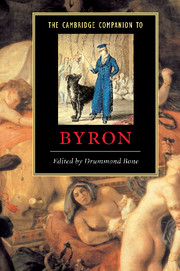Book contents
14 - Byron and the eighteenth century
from Part 3 - Literary Contexts
Published online by Cambridge University Press: 28 May 2006
Summary
The Eighteenth Century was the first to be mythologised as a century. This happened almost as soon as it was over. Byron gives us the reason for this:
Talk not of seventy years as age; in seven
I have seen more changes, down from monarchs to
The humblest individual under heaven,
Than might suffice a moderate century through.
(Don Juan , XI.82.1-4)Byron means here that in seven years he has witnessed Napoleon's surrender, escape from Elba, defeat at Waterloo, and death on St Helena, together with the restoration of the old dynasties that ruled Europe before the French Revolution; but for him, as for us, these changes are all part of a larger single change. For virtually all Europeans, the bewildering events from the Fall of the Bastille in 1789, to the final defeat of Napoleon in 1815, shaped and symbolised a decisive break between eighteenth- and nineteenth-century history. When the cultural events initiated by or accompanying these socio-political changes came to be retrospectively characterised as a single phenomenon called 'The Romantic Movement', then it was natural that this 'movement' should be contrasted with 'The Eighteenth Century' which itself was seen as a single age.
- Type
- Chapter
- Information
- The Cambridge Companion to Byron , pp. 236 - 248Publisher: Cambridge University PressPrint publication year: 2004
- 3
- Cited by



